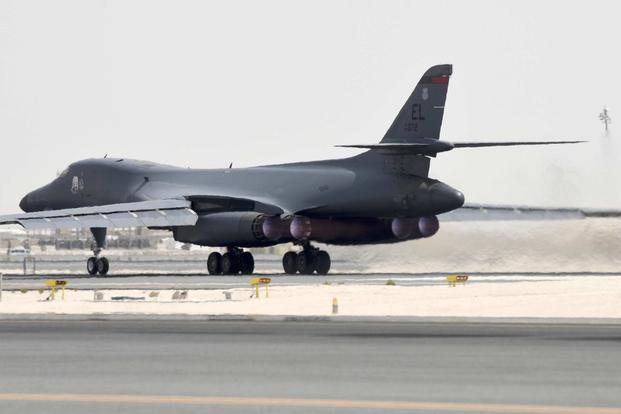The U.S. Air Force overcommitted its B-1B Lancer bomber fleet in Middle East operations over the last decade, causing it to deteriorate more quickly than expected, according to the head of Air Force Global Strike Command.
The bombers were recently called back to the U.S. to receive more upgrades and maintenance to prepare for the next high-end fight.
"We overextended the B-1s in [U.S. Central Command]," Air Force Gen. Timothy Ray, commander of AFGSC, told reporters during a defense writers group breakfast Wednesday in Washington, D.C.
"Normally, you would commit -- [with] any bomber or any modern combat aircraft -- about 40 percent of the airplanes in your possession as a force, [not including those] in depot," he explained. "We were probably approaching the 65 to 70 percent commit rate [for] well over a decade. So the wear and tear on the crews, the maintainers, and certainly the airplane, that was my cause for asking for us to get out of the CENTCOM fight."
Last year, the B-1s returned to the Middle East for the first time in nearly two-and-a-half years to take over strike missions from B-52 Stratofortress bombers. The last rotation of bombers from Dyess Air Force Base, Texas, returned home March 11, according to Air Force Magazine.
Related content:
- Air Force Grounds B-1 Fleet Over New Precautions Concerning Ejection Seat
- Next-Gen Tracking Sensor Could Help Avoid Friendly Fire Accidents
- B-1B Lancer's Evolving Mission Includes More Close-Air Support
"A lot of what we were doing was in support of ground forces in the fight against [the Islamic State], and now you know their status," Ray said, referring to the militants' significantly reduced strongholds in both countries. He said he doesn't foresee a "capability gap" despite the fact there are no bombers deployed, because fighters and other aircraft can focus on Middle East operations, particularly in Afghanistan where airstrikes continue.
Ray said the decision to bring the bombers home from the Middle East is in line with former Defense Secretary Jim Mattis' prioritization of the National Defense Strategy "to turn to the high-end conflict" with near-peer militaries such as Russia or China.
But by the end of March, Ray had ordered the stand-down, marking the second fleetwide stand-down in about a year.
AFGSC officials said that, during a routine inspection of at least one aircraft, airmen found a rigged "drogue chute" incorrectly installed in the ejection seat egress system, a problem that might affect the rest of the fleet.
"A drogue shoot 'rights' an ejection seat when it departs … and I didn't like what I saw," Ray said, so he ordered the March 28 stand-down. The issue is "part of the egress system," the way airmen exit the bomber in an emergency.
Ray said his immediate concern was for the aircrews' safety.
"I don't care how bad the readiness is, your personal safety is more important," he said Wednesday.
The B-1 has experienced three setback "events" in about a year's time, Ray said, referring to an emergency landing incident related to an ejection seat issue and two fleetwide groundings, including the most recent one.
In addition to the recent halt in operations, the command grounded the fleet over safety concerns last year, a problem also related to the Lancer's ejection seats. Officials ordered a stand-down on June 7, 2018, which lasted three weeks while the fleet was inspected.
That stand-down was the direct result of an emergency landing made by a Dyess B-1 on May 1, 2018, at Midland Airport in Texas. Air Force Secretary Heather Wilson confirmed speculation at the time that the B-1 had to make an emergency landing after an ejection seat didn't blow during an earlier in-flight problem.
Months after that incident, UTC Aerospace Systems, manufacturer of the bomber's ACES II ejection seat, said the seat itself is not the problem, but rather the sequence system.
The B-1 has four seats, for the pilot, co-pilot and two weapons systems officers in the back.
The most recent ejection issue does not appear to be related to the issues that occurred last year, AFGSC has said.
Ray said he expects this stand-down to last a while longer.
"A typical aircraft will take seven to 10 days to inspect … to give a very, very thorough scrub of the egress system," he said, adding that the command so far has not discovered any additional concerns from the inspections.
Ray said the command is inspecting roughly three aircraft a week at Dyess and two a week at Ellsworth Air Force Base, South Dakota. The Air Force has 62 Lancers in its fleet. The service plans to retire the bombers in 2036.
"This is going to be a slow and steady process," he said.
-- Oriana Pawlyk can be reached at oriana.pawlyk@military.com. Follow her on Twitter at @Oriana0214.












